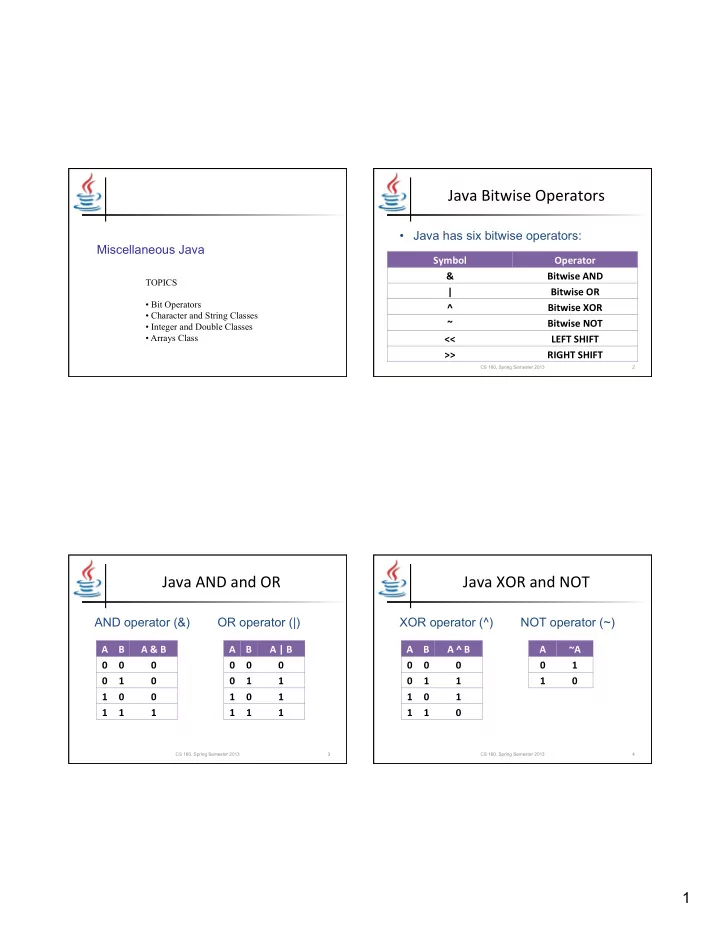

Java ¡Bitwise ¡Operators ¡ • Java has six bitwise operators: Miscellaneous Java Symbol ¡ Operator ¡ & ¡ Bitwise ¡AND ¡ TOPICS | ¡ Bitwise ¡OR ¡ • Bit Operators ^ ¡ Bitwise ¡XOR ¡ • Character and String Classes ~ ¡ Bitwise ¡NOT ¡ • Integer and Double Classes • Arrays Class << ¡ LEFT ¡SHIFT ¡ >> ¡ RIGHT ¡SHIFT ¡ CS 160, Spring Semester 2013 2 Java ¡AND ¡and ¡OR ¡ Java ¡XOR ¡and ¡NOT ¡ AND operator (&) OR operator (|) XOR operator (^) NOT operator (~) A ¡ B ¡ A ¡& ¡B ¡ A ¡ B ¡ A ¡| ¡B ¡ A ¡ B ¡ A ¡^ ¡B ¡ A ¡ ~A ¡ 0 ¡ 0 ¡ 0 ¡ 0 ¡ 0 ¡ 0 ¡ 0 ¡ 0 ¡ 0 ¡ 0 ¡ 1 ¡ 0 ¡ 1 ¡ 0 ¡ 0 ¡ 1 ¡ 1 ¡ 0 ¡ 1 ¡ 1 ¡ 1 ¡ 0 ¡ 1 ¡ 0 ¡ 0 ¡ 1 ¡ 0 ¡ 1 ¡ 1 ¡ 0 ¡ 1 ¡ 1 ¡ 1 ¡ 1 ¡ 1 ¡ 1 ¡ 1 ¡ 1 ¡ 1 ¡ 0 ¡ CS 160, Spring Semester 2013 3 CS 160, Spring Semester 2013 4 1
Binary ¡to ¡Decimal ¡ Binary ¡to ¡Decimal ¡ • 0-‑9 ¡are ¡used ¡for ¡decimal ¡numbers ¡(base-‑10): ¡ Decimal ¡ Binary ¡ Decimal ¡ Binary ¡ – 149 ¡= ¡1*10 2 ¡+ ¡4*10 1 ¡+ ¡9*10 0 ¡ 0 ¡ 0000b ¡ 8 ¡ 1000b ¡ • 0-‑1 ¡are ¡used ¡for ¡binary ¡numbers ¡(base-‑2): ¡ 1 ¡ 0001b ¡ 9 ¡ 1001b ¡ – 1010b ¡= ¡1*2 3 ¡+ ¡0*2 2 ¡+ ¡1*2 1 ¡+ ¡*2 0 ¡ = ¡8 ¡+ ¡2 ¡= ¡10 ¡ 2 ¡ 0010b ¡ 10 ¡ 1010b ¡ • Example: ¡ 3 ¡ 0011b ¡ 11 ¡ 1011b ¡ – 10111b ¡in ¡decimal? ¡ 4 ¡ 0100b ¡ 12 ¡ 1100b ¡ – 1*2 4 ¡+ ¡0*2 3 ¡+ ¡1*2 2 ¡+ ¡1*2 1 ¡+ ¡1*2 1 ¡= ¡16 ¡+ ¡4 ¡+ ¡2 ¡+ ¡1 ¡= ¡23 ¡ 5 ¡ 0101b ¡ 13 ¡ 1101b ¡ – What ¡is ¡14 ¡in ¡binary? ¡ 6 ¡ 0110b ¡ 14 ¡ 1110b ¡ – 8 ¡+ ¡4 ¡+ ¡2 ¡= ¡1*2 3 ¡+ ¡1*2 2 ¡+ ¡1*2 1 ¡+ ¡0*2 0 ¡= ¡1110b ¡ 7 ¡ 0111b ¡ 15 ¡ 1111b ¡ CS 160, Spring Semester 2013 5 CS 160, Spring Semester 2013 6 Bitwise ¡Operator ¡Examples ¡ Masking ¡Opera^ons ¡ • 4-‑bit ¡numbers: ¡ • Clearing ¡bits: ¡ – 6 ¡& ¡5 ¡= ¡0110b ¡& ¡0101b ¡= ¡0100b ¡= ¡4 ¡ – x ¡= ¡00101001b ¡= ¡41 ¡ – 6 ¡| ¡5 ¡= ¡ ¡0110b ¡| ¡0101b ¡= ¡0111b ¡= ¡7 ¡ – want ¡to ¡clear ¡top ¡4-‑bits ¡ – 6 ¡^ ¡5 ¡= ¡0110b ¡^ ¡0101b ¡= ¡0011b ¡= ¡3 ¡ – x ¡= ¡x ¡& ¡00001111b ¡= ¡x ¡& ¡15 ¡= ¡00001001b ¡= ¡9 ¡ – ~6 ¡= ¡~0110b ¡= ¡1001b ¡= ¡9 ¡ • Seang ¡bits: ¡ • 8-‑bit ¡numbers: ¡ – x ¡= ¡00101001b ¡= ¡41 ¡ – 6 ¡<< ¡3 ¡= ¡00000110b ¡<< ¡3 ¡= ¡00110000b ¡= ¡48 ¡(6 ¡* ¡8) ¡ – want ¡to ¡set ¡bobom ¡4-‑bits ¡ – 48 ¡>> ¡4 ¡= ¡00110000b ¡>> ¡4 ¡= ¡00000011b ¡= ¡3 ¡(48 ¡/ ¡16) ¡ – x ¡= ¡x ¡| ¡00001111b ¡= ¡x ¡| ¡15 ¡= ¡00101111b ¡= ¡47 ¡ CS 160, Spring Semester 2013 7 CS 160, Spring Semester 2013 8 2
Character ¡Class ¡ String ¡Class ¡ • Methods ¡that ¡detect ¡types ¡of ¡characters: ¡ • Methods ¡that ¡manipulate ¡strings: ¡ – Character.isUpperCase(char ¡c); ¡ – String.toUpperCase(); ¡ – Character.isLowerCase(char ¡c); ¡ – String.toLowerCase(); ¡ – Character.isDigit(char ¡c); ¡ – String.substring(int ¡beginIndex, ¡int ¡endIndex)l ¡ – Character.isLeber(char ¡c); ¡ • Example ¡using ¡String ¡s ¡= ¡“HelloThere”; ¡ – Character.isSpace(char ¡c); ¡ – s.toUpperCase() ¡returns ¡“HELLOTHERE” ¡ • Example: ¡ – s.toLowerCase() ¡returns ¡“hellothere” ¡ – Character.isLeber(‘8’) ¡== ¡false ¡ – s.substring(2,7) ¡returns ¡“lloTh” ¡ – Character.isLowerCase(‘a’) ¡== ¡true ¡ CS 160, Spring Semester 2013 9 CS 160, Spring Semester 2013 10 Integer ¡and ¡Double ¡Classes ¡ Arrays ¡Class ¡ • Methods ¡that ¡parse ¡strings ¡to ¡return ¡numbers: ¡ • Methods ¡to ¡manipulate ¡arrays: ¡ – Integer.parseInt(String ¡s); ¡ – Arrays.toString(int ¡array[]); ¡ – Double.parseDouble(String ¡s); ¡ – Arrays.sort(int ¡array[]); ¡ – Arrays.equals(int ¡a1[], ¡int ¡a2[]); ¡ • Example: ¡ • Example ¡using ¡int ¡array[] ¡= ¡{4, ¡3, ¡5, ¡2, ¡1}; ¡ – Integer.parseInt(“154”) ¡returns ¡154 ¡ – Double.parseDouble(“12.5”) ¡returns ¡12.5 ¡ – Arrays.toString(array) ¡returns ¡“[4, ¡3, ¡5, ¡2, ¡1]” ¡ – Integer.parseInt(“Hello”) ¡gets ¡an ¡excep^on ¡ – Arrays.sort(array) ¡sorts ¡array ¡to ¡{1, ¡2, ¡3, ¡4, ¡5} ¡ ¡ – Double.parseDouble(“There”) ¡gets ¡an ¡excep^on ¡ – Arrays.equals(array, ¡array} ¡= ¡true ¡ CS 160, Spring Semester 2013 11 CS 160, Spring Semester 2013 12 3
Recommend
More recommend